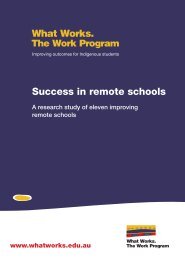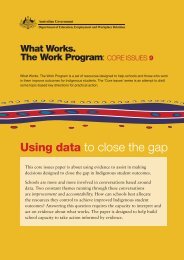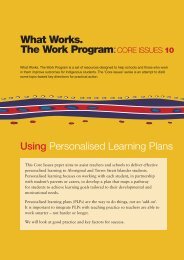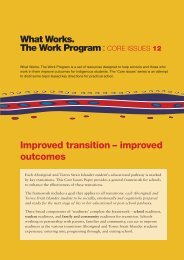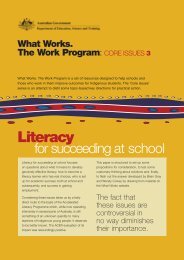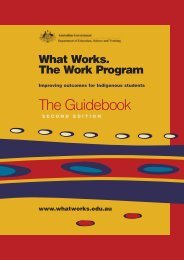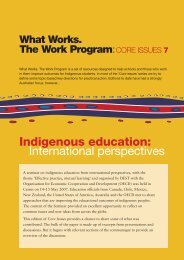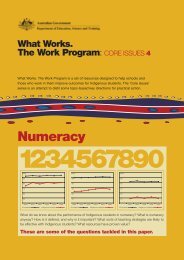Bound for Success Scope and Sequence Statements
Bound for Success Scope and Sequence Statements
Bound for Success Scope and Sequence Statements
- No tags were found...
You also want an ePaper? Increase the reach of your titles
YUMPU automatically turns print PDFs into web optimized ePapers that Google loves.
ENGLISHWriting In<strong>for</strong>mation <strong>and</strong> Argument TextsIn Years 1, 2 <strong>and</strong> 3 students write simple recounts, descriptions <strong>and</strong> explanations in print <strong>and</strong> electronic mediums onfamiliar topics <strong>for</strong> known readers.In Years 4, 5 & 6 students write in<strong>for</strong>mation texts that may include descriptions, reports, explanations, <strong>and</strong> simple argumentsin print <strong>and</strong> electronic mediums. Students write <strong>for</strong> known audiences, draw on their own experiences <strong>and</strong> write on someunfamiliar ideas or in<strong>for</strong>mation by researching topics.In Years 7 & 8 students write texts that may include reports, personal recounts, autobiographies <strong>and</strong> arguments, in print <strong>and</strong>electronic mediums, <strong>for</strong> unknown or specified audiences. Students explore some challenging ideas <strong>and</strong>/or argue a point ofview.In Years 9 & 10 students write text in print <strong>and</strong> electronic mediums, which deal with ideas <strong>and</strong> issues about which theywould like to effect change. They write to persuade a general or particular audience to change their point of view, <strong>and</strong>/or totake action. Their texts may include biographies, advertisements, news articles, features, letters to the editor <strong>and</strong> reviews.In Year 1the student:In Year 2the student:In Year 3the student:In Year 4the student:In Year 5the student:In Year 6the student:In Year 7the student:In Year 8the student:In Year 9the student:In Year 10the student:underst<strong>and</strong>s that :o in<strong>for</strong>mation texts caninclude people, places,events <strong>and</strong> things whichare personally significanto descriptions, recounts <strong>and</strong>reports have specificstructuresunderst<strong>and</strong>s that :o in<strong>for</strong>mation texts c<strong>and</strong>escribe people, places,events <strong>and</strong> thingso descriptions,explanations, procedures<strong>and</strong> reports, have specificstructuresunderst<strong>and</strong>s that :o in<strong>for</strong>mation texts c<strong>and</strong>escribe people, places<strong>and</strong> events <strong>and</strong> give anopiniono an opinion may bepositive or negativeo in<strong>for</strong>mation <strong>and</strong> argumenttexts have a specificstructureunderst<strong>and</strong>s that :o in<strong>for</strong>mation <strong>and</strong> argumenttexts can report <strong>and</strong>explain in<strong>for</strong>mation <strong>and</strong>events <strong>and</strong> give opinions(e.g. Talking about Beingan Immigrant by SarahLevete <strong>and</strong> FranklinWatts)o writers can reflect theopinions of the intendedreaders <strong>and</strong> viewers fromdifferent cultures, groups<strong>and</strong> individuals in theirtextunderst<strong>and</strong>s that :o writers can influenceothers’ opinionso others can be influencedby including or omittingin<strong>for</strong>mation <strong>and</strong> makingparticular languagechoices (e.g. to create apositive or negativeperspective)underst<strong>and</strong>s that :o choices of subject matter,language <strong>and</strong> genericstructure are made tosupport the purpose of thewriter <strong>and</strong> appeal todifferent audiencesunderst<strong>and</strong>s that :o ideas <strong>and</strong> in<strong>for</strong>mation canbe selected to support theposition or purpose of thewriter <strong>and</strong> appeal to, orsuit, different audienceso arguments systematicallyuse a <strong>for</strong>mal, logicalstructure to argue a caseunderst<strong>and</strong>s that :o in<strong>for</strong>mation <strong>and</strong> argumenttexts can be constructed<strong>for</strong> more than one purpose<strong>and</strong> audience typeo research may be needed rto acquire in<strong>for</strong>mation <strong>for</strong>argument textso arguments advanceopinions, justify positions<strong>and</strong> make judgements inorder to persuade otherso writers choose subjectmatter, attributes,processes <strong>and</strong> visualresources to constructrepresentations of people,places, events <strong>and</strong> thingsin ways that appeal tocertain groupsunderst<strong>and</strong>s that :o in<strong>for</strong>mation <strong>and</strong> argumenttexts require explanations,details <strong>and</strong> evidence,which may requireresearcho writers want readers toempathise with the ideas<strong>and</strong> emotions expressedor implied in their writingo writers select subjectmatter <strong>and</strong> language to tryto position readers toaccept representations ofpeople, events, ideas <strong>and</strong>in<strong>for</strong>mationunderst<strong>and</strong>s that :o writers need to developsufficient knowledge ofcomplex social issues toelaborate details insupport of an argument,or to construct credibleexplanations of situations,conflicts <strong>and</strong>/ormotivationso audiences are likely tohave certain expectationsabout texts <strong>and</strong> thatwriters can make choicesto accommodate, resist orsubvert those expectationso writers include, excludeor emphasise certainsubject matter to serveown purposes in textconstructionwrites texts that:o use some stages ofgeneric structure <strong>for</strong>Descriptions, Recounts<strong>and</strong> Reports – whensupported by scaffoldingo include in<strong>for</strong>mationwhich relates to the mainideawrites texts that:o use the modelled genericstructure texts <strong>for</strong>descriptions,Explanations, Procedures<strong>and</strong> Reportso maintain an idea or topicthroughout related pagesor sectionso include several items ofin<strong>for</strong>mation about themain ideawrites texts that:o order in<strong>for</strong>mation orsequence events usingsome detail <strong>and</strong>/orsupporting illustrativematerialo present own opinion on atopico support their opinion withat least one or tworeasons, or a simpleexplanation based onpersonal judgementwrites texts that:o provide a generalstatement or introductionto the topico develop the topic with afew supporting ideas,explanations <strong>and</strong>/ordescriptionso begin to <strong>for</strong>mulatepersonal judgements inargument textswrites texts that:o provide a generalstatement or introductionto the topico develop the topic with afew supporting ideas,explanations, opinions<strong>and</strong>/or descriptionso (<strong>for</strong> argument texts) makea personal judgemento support the judgementwith a few points orargumentswrites texts that:o (<strong>for</strong> in<strong>for</strong>mation texts)provide an introductionthat outlines the topicfollowed by a few pointsthat are logicallyorganisedo (<strong>for</strong> argument texts)provide an introductionthat states their positionfollowed by supportingargumentso (<strong>for</strong> argument texts) drawconclusionswrites texts that:o (<strong>for</strong> in<strong>for</strong>mation texts)provide an introductionthat outlines the scope ofthe topic, <strong>and</strong> thendevelops the topic withideas, descriptions,opinions <strong>and</strong>/orexplanations that arelogically organisedo (<strong>for</strong> argument texts)provide an introductionthat states their position;<strong>and</strong> then presentssupporting arguments thatmay include some detailsor evidence, <strong>and</strong> aconclusiono (<strong>for</strong> argument texts)conclude the text with arestatement of theirpositionwrites texts that:o draw on research toconstruct subject matter<strong>and</strong> support theirarguments or opinionso provide a statement oftheir own positiono provide a major point toeach paragrapho conclude with arestatement of theirposition or a summary ofthe main argumentswrites texts that:o make appropriateselections of in<strong>for</strong>mationfrom a few sources, <strong>and</strong>attempt to synthesise <strong>and</strong>organise this in a logicalsequenceo provide a statement oftheir own position or themajorperspectives/concerns ofthe issue <strong>and</strong> preview thearguments or the structureof the in<strong>for</strong>mation tofollowo structure texts to providea major point to eachparagraph with someelaborationo conclude with arestatement of theirposition or a summary ofthe main arguments,issues orrecommendationswrites texts that:o include evidence fromnamed <strong>and</strong>/or referencedsources to support <strong>and</strong>refute arguments withinexpositions, discussions<strong>and</strong> reviewso provide a statement oftheir own position or themajor perspectives/concerns of the issue, <strong>and</strong>preview the arguments orthe structure of thein<strong>for</strong>mation to followo provide a major point toeach paragraph with someelaborationo conclude with arestatement of theirposition or a summary ofthe main arguments,issues orrecommendationsknows <strong>and</strong> uses:o a small range of topicrelatedvocabularyo textual <strong>and</strong> visualresources includingdescriptive words <strong>and</strong>images to representpeople, places, events <strong>and</strong>thingso generic structure <strong>and</strong> textfeatures <strong>for</strong>:knows <strong>and</strong> uses:o topic related vocabularyo textual <strong>and</strong> visualresources includingdescriptive words,images, facial expressions<strong>and</strong> gestures to representpeople, places, events <strong>and</strong>thingso generic structure <strong>and</strong> textfeatures <strong>for</strong>:knows <strong>and</strong> uses:o simple sentences inappropriate grammaticalorder <strong>for</strong> statementso vocabulary <strong>and</strong> word<strong>for</strong>ms appropriate to thesubject matter of the texto some specific or technicalvocabulary whereappropriateo thinking, feeling <strong>and</strong>knows <strong>and</strong> uses:o subject-specificvocabulary whereappropriateo processes /verbs groupsexpressing action (e.g.will fly) <strong>and</strong> speech (e.g.was reported)o adjectives to compare(e.g. funny, funnier,funniest <strong>and</strong> someknows <strong>and</strong> uses:o particular adjectives <strong>and</strong>verbs to express ideas <strong>and</strong>in<strong>for</strong>mation positively ornegativelyo linking words (e.g. firstly,secondly, or, so, when) tostructure their text, linkideas <strong>and</strong> give reasonso referring words (e.g. this,those, these) to link ideasknows <strong>and</strong> uses:o particular adjectives <strong>and</strong>verbs to express opinions<strong>and</strong> give an evaluation ofideas <strong>and</strong> in<strong>for</strong>mationo subject-verb <strong>and</strong> nounpronounagreemento conjunctions that connectclauses to <strong>for</strong>m compoundor complex sentenceso graphic elements,knows <strong>and</strong> uses:o research <strong>and</strong> note takingskills using print <strong>and</strong>electronic media (e.g.Web Quest)o graphic elements <strong>and</strong>/orheadings <strong>and</strong> subheadingsto organise presentations,research or otherin<strong>for</strong>mationo paragraphs to order <strong>and</strong>knows <strong>and</strong> uses:o research <strong>and</strong> note takingskills using print <strong>and</strong>electronic mediao graphic elements (e.g.layout <strong>and</strong> hyperlinks) toorganise text <strong>for</strong> readers<strong>and</strong> viewerso paragraphs to sequenceideas <strong>and</strong> eventso specialist words,knows <strong>and</strong> uses:o research <strong>and</strong> note takingskills using print <strong>and</strong>electronic mediao ordering of paragraphs tobest support <strong>and</strong> sustainan argument <strong>and</strong> toorganise <strong>and</strong> conveyin<strong>for</strong>mation clearlyo concrete, technical,abstract (noun groups orknows <strong>and</strong> uses:o research <strong>and</strong> note takingskills using print <strong>and</strong>electronic mediao ordering of paragraphs tobest support <strong>and</strong> sustainan argument <strong>and</strong> toorganise <strong>and</strong> conveyin<strong>for</strong>mation clearlyo specialist subject matterfrom a wide range of<strong>Bound</strong> <strong>for</strong> <strong>Success</strong> <strong>Scope</strong> <strong>and</strong> <strong>Sequence</strong> <strong>Statements</strong> V2 Page 10 Working Document Semester One 2007



